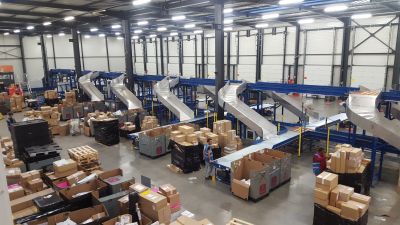
The most common forms of conveyor utilise roller technology, depending on requirements, speeds, product type and budget there are several types of roller conveyor available. The modular design allows for cost effective integration of conveyor modules to create highly efficient and adaptable materials handling solutions.
Benefits:
- Greater control features and operational functionality
- Cost Effective
- Modular allowing flexibility and future expansion
- A wide range of auxiliary interfaces available
- Low Maintenance
Powered roller conveyors are the flexible solution to accommodate a wide range of products required for automated handling for most flat based products such as tote handing, cases, cartons etc.
Gravity roller conveyor

The gravity roller conveyor is a frame that holds free-rotating rollers and uses gravity to slide material down the line. They are used to carry light to medium weight products that do not require a motor, which makes them economical solutions for designers. They can be purchased with accessories such as curves, pop up stops, supports and hanging brackets, slide rails, and more, and are often made from steel, aluminum, and plastic. They are often implemented as temporary conveyors, alternatives for skate wheel conveyors, heavy-duty applications, and accumulating loads that do not require any specialized timing.
Belt driven roller conveyor

The belt -driven live roller conveyor utilizes a motorized belt to power each roller, allowing this conveyor type to control the motion of the materials being transported. They are preferred over typical belt conveyors when items must be stopped momentarily at control points, items must be turned, and/or side loading or slide unloading is necessary. The belt can be straight or can be in a V shape for curved roller conveyors. Some belt-driven roller conveyors can support products wider than the frame width, thanks to the rollers being higher than the frame. In any arrangement, the rubber belt underneath the rollers must not encounter moisture, excessive heat, or debris as these conditions can quickly degrade the system. These conveyors are often used for handling medium to heavy loads that are dry and clean, and which require periodic stopping and/or reversible action.
Chain driven roller conveyor

The chain - driven roller conveyor is like the belt-driven conveyor, but instead of using belts it implements a chain to power each roller. They are used when heavy-duty conveying is required and where adverse conditions prevent the use of typical belt-driven conveyors. Figure 4 shows a roll-to-roll chain conveyor, where the chain is wrapped around each roller and holds on to two sprockets on each roller. These are best suited for reversible operations and extreme duty loads, as the power transmission is high in these designs. These are distinct from the single strand chain driven roller conveyor, where the rollers are driven by a single, non-looped continuous chain via sprockets on the roller. A continuous hold-down bar always keeps the chain engaged, but these conveyors are only rated for medium-to- heavy-duty service as they are not as powerful as their roll-to-roll counterpart.
Line shaft roller conveyor

Line shaft roller conveyors are powered, as their name implies, by a rotating shaft where each roller is belted to this powered shaft. They are separately connected to the line shaft via urethane belts and drive spools, making this type of conveyor quiet and easy to maintain. While still a powered roller conveyor, the drive spools will slip in the presence of minimal back pressure (the force on the rollers when material has accumulated and cannot move down the line), causing the rollers to simply stop without impacting others. A line shaft can power over 100 feet of both straight and curved rollers, increasing the efficiency of the conveyor system. They are reversible and ideal for accumulation, minimum back pressure, sorting, and other medium-to light-duty applications.
Zero pressure roller conveyor

Zero pressure roller conveyors (also known as pressureless accumulating conveyors ) are made to prevent any items from touching while on the conveyor. They are a high-tech control system that utilizes sensors and motors to energize and de-energize certain ‘zero pressure’ zones of the track. By doing so, a buffer zone is created between products, allowing no accumulation to occur. Certain rollers are internally powered by motors that are connected directly to the control system, and photocells detect when a product has passed into/out of zones. They can be bought as kits to retrofit older conveyor systems and are the premier choice for automation applications where timing, rate of movement, and consistency are needed. While more complicated and electronically actuated than previous roller conveyors, zero pressure designs are quite efficient and regulate the flow of material, creating an overall smoother transfer.
Các sản phẩm khác
Copyright © 2015 by Lienminhco. All Rights Reserved.









































